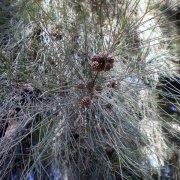Care of the tree Casuarina cunninghamiana or River oak |
|
The genus Casuarina, family Casuarinaceae, includes 15 species of trees native to Australia, Asia, and some islands in the Pacific Ocean. Some species are: Casuarina cunninghamiana, Casuarina equisetifolia, Casuarina teres, Casuarina glauca, Casuarina cristata. Common names: River oak, River she-oak. This species is native to northern and eastern Australia. They are large pyramidal trees, very similar to pine, reaching 30 meters (98.4 feet) in height. The scaly needle-shaped leaves are chlorophyll-free and arise from green stems. They produce conical shaped female flowers and male flowers in spikes. The fruits are small conifers. River oak is used in large gardens because the roots develop a lot and do not allow nearby species to grow. It's ideal to fix sandy areas and to create barriers to the saltpeter of the sea. It's also used in public streets and parks and in pots when young. Casuarina cunninghamiana needs full sun exposure and warm or temperate temperatures; it resists frosts down to -3 ºC (26.6 ºF). River she-oak prefers sandy soils with a little organic matter such as peat or leaf mulch; it can grow in poor soils. Planting is done in autumn. Water regularly, waiting for the substrate to be almost dry; they resist a few days of drought. Adult specimens do not need pruning. Prune young plants lightly in late winter to keep them compact. Casuarina cunninghamiana is a resistant tree to the usual pests and diseases. River oak is propagated from seed and by cuttings in early fall or spring. |
Images of the tree Casuarina cunninghamiana or River oak |
Find plants
Casuarina cunninghamiana or River oak | Care and Growing
© 2025 FavThemes

